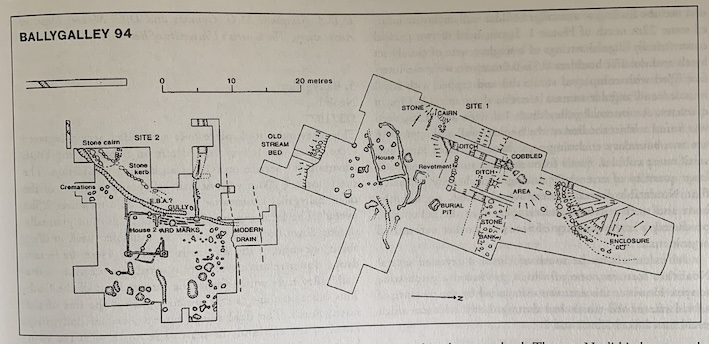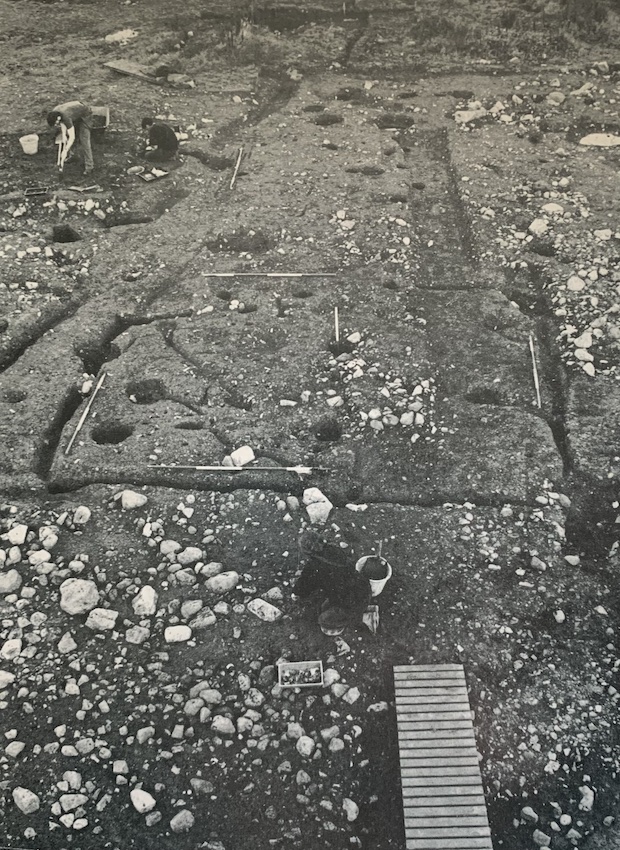1994:004 - BALLYGALLEY (Croft Manor), Antrim
County: Antrim
Site name: BALLYGALLEY (Croft Manor)
Sites and Monuments Record No.: SMR 35:54
Licence number: —
Author: D.D.A. Simpson, M.G. Conway and D.G. Moore, Dept. of Archaeology, The Queen's University of Belfast
Author/Organisation Address: —
Site type: Settlement cluster and Industrial site
Period/Dating: Prehistoric (12700 BC-AD 400)
ITM: E 737322m, N 907488m
Latitude, Longitude (decimal degrees): 54.896275, -5.859107
Excavations by the Department of Archaeology QUB financed by the Environment Service DoE (NI) continued at the Croft Manor housing development site at Ballygalley for a final sixth season over 25 weeks from June 13 to December 14. First discovered in 1989, subsequent excavations concentrated on an area which had produced prolific quantities of finds and features. The excavation area is divided between two major cuttings: Site 1: 926 sq m and Site 2: 500 sq m in area. The position of the cuttings and the major archaeological features referred to in this text can be found in the accompanying figure.
Both Sites 1 and 2 were characterised by several successive cobbled surfaces which displayed a marked difference in the stone sizes of their construction. The upper level used larger stones (avg: 0.05m–0.1m in size) while the lower level consisted of a cobbled surface of smaller stones. Both levels contained vast quantities of flint artefacts of varying quality (dominated by scrapers), as well as flakes, cores and industrial flint waste. Other finds included porcellanite axes and flakes, pitchstone flakes, hammerstones, rubbers, quern fragments, stone beads and pottery, most of which was plain shouldered and unshouldered bowls and lesser quantities of decorated late Neolithic forms (mostly Sandhills Ware), which were concentrated within the upper level. The two Neolithic houses and the vast majority of pits and gullies excavated come from the lower level.
Site 1
Excavation concentrated on the area to the north of House 1 and the probable revetment and was characterised by the presence of some important new discoveries. Six metres to the north of the revetment, a linear arrangement of large boulders and occasional flat slabs running east-west, partially excavated at the end of the 1993 season, was found to be over 17m long and 2–3m wide. It was flanked on its southern side by a U-shaped ditch 2m wide and almost 1m deep, from which several sherds of coarse pottery (possibly of middle to late Bronze Age date) were recovered in 1993. A second earlier ditch, of similar dimensions, was located 1.5m to the south lying directly below the compacted stone and soil platform (containing Neolithic finds including a Langdale flake) on which the revetment was constructed and through which the first ditch was cut. This ditch produced a large quantity of lithic finds as well as pottery of Neolithic character. The revetment itself was found to be part of a complex setting of features and deposits, consisting of a V-shaped stone-packed slot 2.5m long, 0.8m wide and 0.8m deep lying roughly at a right angle (north-south) to the line of the revetment stones. The slot contained a large volume of flint including an arrowhead, flakes of porcellanite and pitchstone, sherds of Neolithic pottery and animal teeth. Several related features were set in close proximity to the slot suggesting that it had structural significance. Finds from these related features appear consistent in type and date with those recovered from the slot.
A small low cairn located almost 6m to the north-west of House 1 was found to be roughly 5m in diameter and was characterised by a centrally placed setting of burnt stones resembling an elongated hearth. This lay on the compacted ‘floor’ of the cairn which consisted of a loosely kerbed arrangement of small rounded stones; the whole was then covered by larger more irregular shaped stones to form the cairn mass. Finds were all Neolithic in character.
The most significant discovery from this season of excavation was the finding of a circular boulder wall enclosure located some 22m north of House 1. It consisted of two parallel concentrically aligned settings of a single course of closely set basalt and dolerite boulders 0.55–0.8m apart, with the interface filled with compacted sterile soil and capped with small rounded and angular stones. It enclosed an area 12–15m in diameter. An internal gulley/ditch 1m wide and 0.5m deep was found within the line of the boulder wall and appears to act as a boundary enclosing a platform of mixed large and small stone cobbles. Finds from the enclosure consisted of a large quantity of essentially undiagnostic heavily patinated flint. No datable pottery was uncovered though, significantly, bone and teeth survived and samples from the gulley have produced a large quantity of seeds and other carbonised organic material.
An extension to the south of House 1 revealed several Neolithic features, one of which produced a pitchstone scraper. However this area was dominated by the presence of an old stream bed which had destroyed any evidence which could have linked Sites 1 and 2.
Site 2
The excavation of House 2 was completed. It has the same orientation as House 1 located 35m to the north but differs in plan. House 2 consisted of a bedding trench along three sides while the north side consisted of a combination of post and slot. The structure measures 4.8m by 5.6m and has internal support with a central load-bearing posthole 0.7m in depth. A large number of stakeholes were uncovered in and around the house along with shallow pits and curving slots, many of which post-date the house. On the northern side of House 2 a series of ard-marks were found running north-south and east-west and these also appear to post-date House 2.
West of House 2 a large area of artefact-rich cobbling was found containing a linear setting of large boulders running south-west/north-east with a small stone cairn at its south-western end. The cairn contained large quantities of burnt bone. Further slots were uncovered around the house, to the east and north-east, both running approximately east-west. The north-east slot was found to increase in width and depth (from 0.5m to 1.2m) as it ran westwards. This slot contained some interesting finds including several unpolished Langdale flakes and a small piece of gold leaf, all from its upper fill.
A long curving gulley was also located to the west of House 2. It appears to be late in construction and contains no datable finds. The fill of the gulley consists of a homogenous sticky grey-blue clay and while analysis of this material is presently under way, it is reasonable to assume that the gulley is a boundary-like feature.
Seven un-urned human cremations were found in shallow pits concentrated to the south-west of House 2, associated with a barbed and tanged arrowhead and some undecorated Early Bronze Age pottery sherds. These cremations are the last phase of activity on Site 2.
Site 2 again produced a large quantity of pottery, flint manufacturing debris and artefacts. Several complete porcellanite axes and axe fragments were recovered as well as pitchstone flakes and rock crystal. Amongst the most notable finds were a badly weathered schist axe and a small cache of hollow scrapers found associated with the cobbles to the west of House 2.

A photo of excavations at Ballygalley, House 2, featured on the cover of the 1994 Excavations bulletin (photo courtesy of Derek Simpson).

